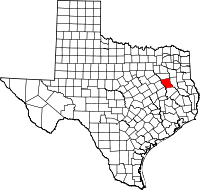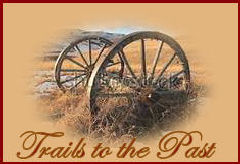| Anderson County: History |

While
this country has a great variety of resources, its chief rank in recent
years has been in horticulture, and it claims the honor of being "the
home of the Elberta peach." The growing of fruits, especially peaches,
was proved to be a profitable industry more than thirty years ago, but
the industry has been on a commercial scale only for about ten or
fifteen years, and it is said that few of the orchards in the county are over ten years old. While few counties of the state have more than a hundred thousand trees in "orchard fruits," Anderson County
at the last census had about 243,000 trees in such fruit, and
approximately 213,000 were classified as peach or nectarine.
Associations have been organized to promote the interests of fruit
growers and market the crops, and during a portion of the year the
chief business of Anderson County people is the gathering, packing and shipping peaches and other fruits.
Hardly a third of the lands in the county
are cultivated, and originally, with the exception of a few prairies,
almost the entire surface was densely wooded. Along the Neches River,
which forms the eastern
boundary, there are extensive tracts of the short-leaf pine, and
this
timber together with large bodies of hardwood have long afforded
resources for lumber manufacture. At the last census 3,773 farms
were reported in Anderson County,
as compared with 3,261 at the preceding census. The total area is
approximately 600,320 acres, of which 375,929 acres were enclosed in
farms, with about 172,000 acres in "improved land." The stock
industry is combined with general farming, and, as in the case of most
wooded counties, the raising of hogs constitutes an important
asset. There were in 1910, 24,223 cattle; about 8,000 horses and mules;
25,941 hogs; and 92,736 poultry. Corn and cotton were the staple
crops, 48,673 acres being planted to cotton in 1909, and
46,495 acres to corn. More than 1,100 acres were in potatoes and sweet
potatoes, and over 900 acres in other vegetables. The growing of
peanuts is a profitable resource, and the county
also claims consideration for its hay and forage crop, and in the
vicinity of Palestine is some Orangeburg soil well adapted to the
cultivation of tobacco.
Anderson County, lying between the Trinity and Neches rivers, was erected from a portion of Houston County,
which lies to the south, on January 13, 1846. Its lands were originally
covered by the Burnet grant of 1826, and a short time before the
Texas Revolution the Galveston Bay Land & Colonization
Company attempted to locate lands under that and other grants.
While many land titles in Anderson County
go back to those original grants, permanent settlement did not begin
until after the Revolution. In 1836, within a few miles of the
present site of Palestine, was established Fort Houston, which, until
it was abandoned in 1841-42, was an important post in the upper
Trinity country, and offered protection against the Cherokee and other
Indian tribes until the removal of those Indians from Eastern Texas.
When Anderson County was first created, it was proposed to call it Burnet County, with the county seat at Fort Houston. This name was changed to honor Kenneth L. Anderson, who had been vice president of the Texas Republic. The county
seat was changed from Fort Houston to Palestine, at which point a
store had been established in 1843, and which then became the
metropolis of the county. There were various other points in the county that became centers of population and some trade. One was Elkhart, in the southern part of the county,
another was Mound Prairie, and still another was Tennessee Colony. The
principal transportation was by the Trinity River, and steamboats
navigated as far north as Anderson County until about 1873. Magnolia and Parker's Bluff in this county
were river ports, the former finally yielding precedence to Tucker, a
railroad station, and the latter transferring most of its
population to Elkhart. The railroad town of Neches is in the vicinity
of old Mound Prairie. Fosterville and Kickapoo were also ante-bellum
villages. The first postoffice of the county was established at Palestine in March, 1847.
The railroad period in Anderson County began with the early '70s. The International Railroad began construction in 1870 at Hearne and was extended as far as Palestine in February, 1872, and completed to Longview by the close of the same year. The construction of the Houston & Great Northern Railroad was begun at Houston and extended north to Trinity by January of 1872, and to Palestine by November of the same year. In September, 1873, both these roads were consolidated under the name International & Great Northern. About the beginning of the present century the Texas & New Orleans Railroad was constructed across the northeast corner of the county, and about 1910 the Texas State Railroad was extended from Rusk to Palestine. As the junction point of the two original railroads comprising the International & Great Northern, Palestine became the general offices and division point and seat of the shops, and it is as a railroad town that Palestine has enjoyed its greatest prosperity.
The population of Anderson County in 1870 was 9,229; in 1880, 17,395; in 1890, 20,923; in 1900, 28,015; and in 1910, 29,650 (11,323 negroes). Taxable values in the county in 1870 were $1,395,025; in 1881, $2,685,650; in 1903, $7,629,682; and in 1913, $13,688,660. Besides the county's material resources in its agriculture and horticulture, its railroad activities at Palestine, the great wealth of timber still furnishes material for mills, and thirty years ago the county had a number of sawmills, shingle and planing factories, and other industries dependent on the forest growth. The county also lies in the iron belt, and during the Civil war the iron deposits supplied raw material for the smelting furnaces in this part of the state. The mining of lignite is a local industry.
Some of the old centers of population in the county
are recalled by a list of the postoffices in 1856: Palestine, Magnolia,
Mound Prairie, Tennessee Colony, Kickapoo, Beaver, Bethel, Elkhart,
Hendersonville, Louis, Roadville, Plenitude, and Marlowe's Mill. At the
present time the important towns outside of Palestine are Elkhart,
Frankston, Neches, Salt City and Herring.
The City of Palestine first owed its importance to the location of the county
seat and then to the advent of the railway in 1872 and the
establishment of the general offices of a large railway system. In 1880
its population was 2,997, in 1890, 5,838, in 1900, 8,297, and in 1910,
10,482. The progressive spirit shown in the city at the coming of the
railway was manifested by the establishment of a waterworks
system in 1882, and it was one of the few cities of the state at that
time to enjoy such facilities. Other improvements have followed, and
the city now claims among its conspicuous features: the railway shops,
with a monthly payroll of nearly $100,000; paved business streets; the
expenditure of $150,000 for the improvement of roads in the immediate
vicinity ; a fine new courthouse, new hotel, and public library; over
$2,000,000
in bank deposits; a complete sewerage system; and the rich surrounding
country, already notable for its fruit crops, and capable of
vastlyincreased development.
Source: A History of Texas and Texans, Volume 2, Pages 868 - 870, by Frank W. Johnson, Published by The American Historical Society (Chicago & New York) in 1914.
To read more about the history of Anderson County, Texas, click here and/or here
View My Stats
TX Trails To The Past
Trails To The Past: National Site
Court Records
Divorces
Events
Family Stories
Law
Marriages
News
Our Family (a project from a friend of Trails To The Past)
Resources
Schools
County Mailing List

